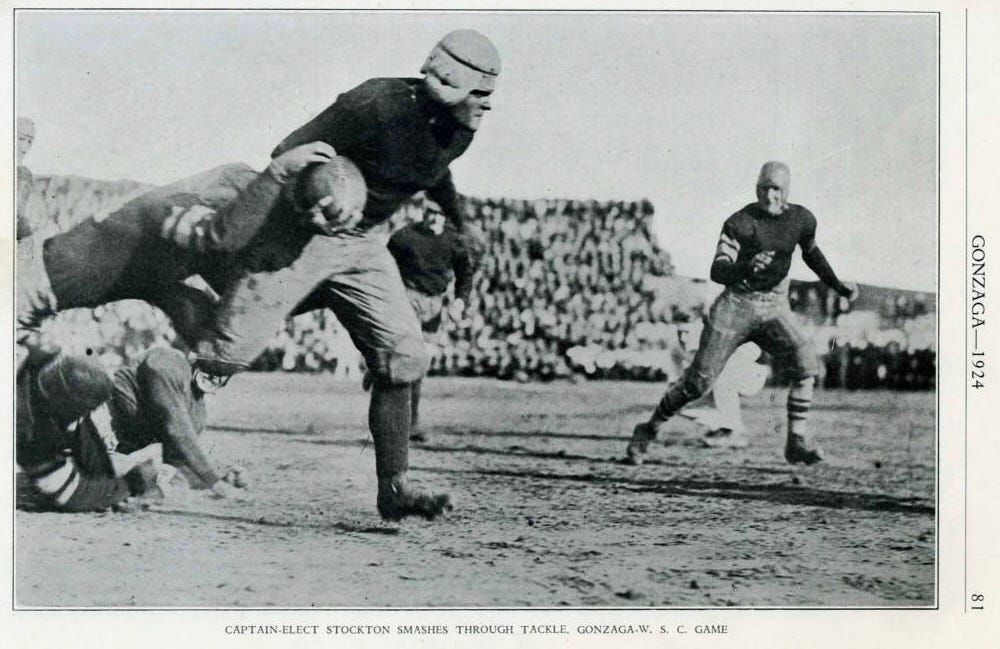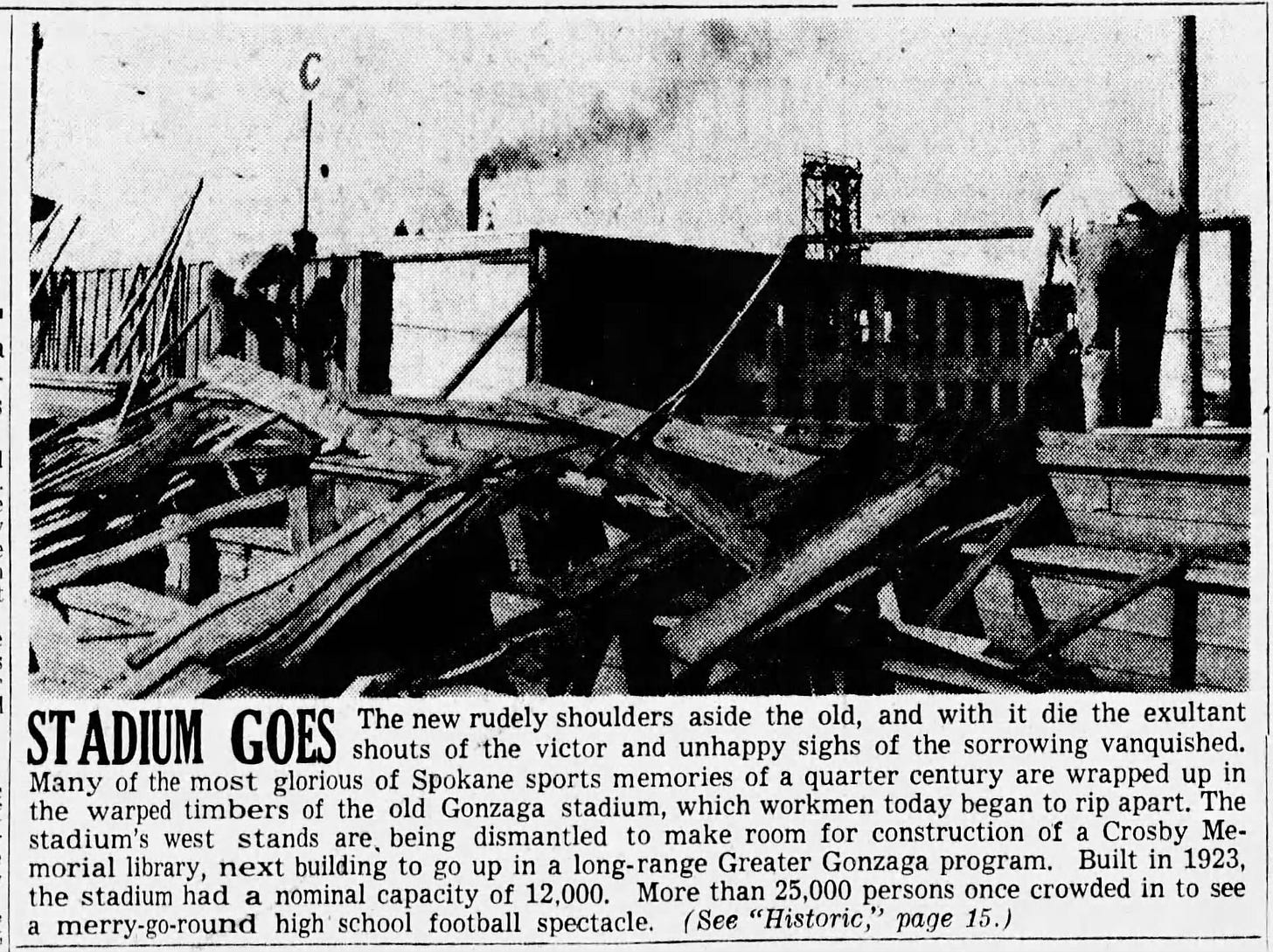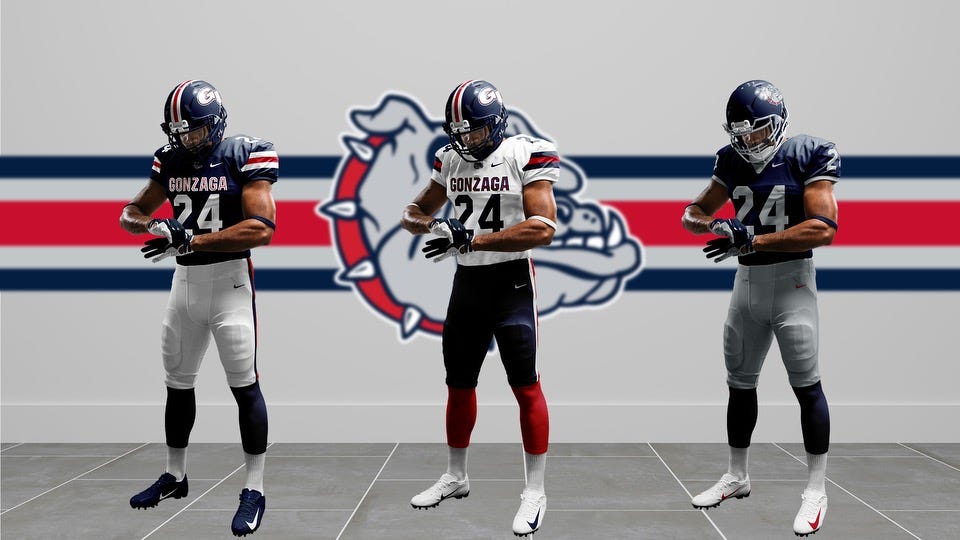Stadium Size, Football Droppers, and Deemphasizers: Gonzaga
This series reviews the program history and stadiums of colleges that dropped or deemphasized football. Click here for the series introduction. The schools included in the review are listed below.
Although I spend significant time reading about football events from long ago, I popped my head into reality yesterday to learn that Gonzaga may join the Pac-12 conference. While I had planned on reviewing Denver as the sixth football dropper, I remain sufficiently light on my research feet to swap Gonzaga for Denver, so here is a late-breaking story on the history of the gridiron Bulldogs.
It is clear that Gonzaga's attraction to the Pac-12 results from the strength of its basketball program, not its football program, but, as you will soon see, there is at least one grand connection between their football and basketball histories.
Gonzaga was a mediocre program throughout its football history, playing a schedule dominated by Northwestern teams. Crosstown rival Washington State, plus Idaho, Montana, Portland, and one or two games per year in exotic locations like Arizona, Los Angeles, San Francisco, and Detroit, allowed the lads to see new parts of the country.
Gonzaga’s physical commitment to football came in 1922 when they built Gonzaga Stadium, which sat 12,000 and once packed in more than 25,000 with temporary bleachers for a high school tournament.


The program's heyday came during Gus Dorais' term as head coach from 1920 to 1924. Dorais famously tossed the ball to Knute Rockne as an undergrad at Notre Dame and became the long-time mentor at the University of Detroit after leaving Gonzaga. His Bulldog teams went 21-13-3 and played in the 1922 San Diego East-West Football Classic, where they fell 21-13 to West Virginia.
Among the stars of those teams was running back Houston Stockton, who played five seasons in the NFL and won the 1926 championship with the Frankford Yellow Jackets. His grandson, John, later played some basketball at Gonzaga.
The 1930s saw a continuation of up-and-down seasons, going 5-4-1 one season and 3-7 the next—never too high and never too low. Still, with an enrollment bouncing between 500 and 600 students, the shift of students from campus to training camps in the early 1940s led them to suspend the football program in the spring of 1942 in favor of a campus-wide physical fitness approach.
The war's end and returning veterans to campus meant Gonzaga had the manpower for a football team; they had excess manpower. A February 1946 statement announced the school would not resume football in 1946 but left open the possibility of returning to the gridiron in 1947 noted:
A further reason for the present decision is the strain put upon the physical resources of the university by the veterans returning to college. Our first obligation is to provide for as many veterans as possible the opportunity of finishing their college education. Our present facilities, especially for out-of-town students, are taxed to capacity and the situation will be even more critical in September.
'Gonzaga University Abandons Gridiron Team Hopes for '46; May Resume in '47.' Spokane Chronicle, February 19, 1946.
Before issuing that statement, Gonzaga had explored scheduling games with multiple schools and had spoken with Babe Hollingbery, Washington State's coach from 1926 to 1942, who lived in the area. Still, low attendance and poor on-the-field performance before the war argued against the game's return.
In addition, although Gonzaga Stadium had suited the school and community well for 25+ years, it was a wooden structure badly in need of repair, and the funds were not available to repair or replace it. Two years later, the city condemned the stadium, and it was demolished in 1949 to make way for a library.
By then, the campus fathers solidly supported leaving football in the rearview mirror, and nothing has changed in the Palouse since then.
2024 Concept Uniform
My brother, Steve, dabbles in sports team logos and uniforms. Here are his concept uniforms for Gonzaga’s imaginary 2024 team.
Next up: Denver U.
Ranking by Stadium Size
Below are the schools reviewed to date, ranked by stadium size. The stadiums’ opening and demolition years (if applicable) are also noted.
Catholic (Brookland Stadium): 30,000 | 1924 - 1985
Denver (DU/Hilltop Stadium): 30,000 | 1925 - 1971
Marquette (Marquette Stadium): 24,000 | 1924 - 1977
Xavier (Corcoran Stadium): 15,000 | 1929 - 1988
Gonzaga (Gonzaga Stadium): 12,000 | 1922 - 1949
California State University, Fullerton (Titan Stadium): 10,000 | 1992 - TBD
Boston University (Nickerson Field): 10,000 | 1915 - TBD
Vermont (Centennial Field): 10,000 | 1923 - TBD
NYU (Ohio Field): 5,000 (est.) | 1897 - 1947
San Francisco (St. Ignatius Stadium): <5,000 (est.) | c. 1909 - c. 1930
Carnegie-Mellon (Skibo Bowl): 4,500 | 1960 - 1987 | Gesling Stadium: 3,900 | 1990 - TBD
Sewanee (McGee Field): 3,000 | 1891 - TBD
Schools to Review
California State University, Long Beach | University of California, Santa Barbara | Case Western | Chicago | CCNY | Creighton | DePaul | Detroit | Drake | Loyola (Chicago) | Nebraska-Omaha | Pacific | St. Louis | Santa Clara | Tampa | Washington University in St. Louis | Wichita State
Football Archaeology is reader-supported. Click here to buy one of my books or otherwise support the site.





Demolishing a football stadium to build a library—what is this world coming to?